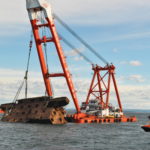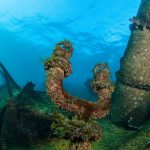Harsh weather conditions and environmental challenges: The removal of the »Rena« wreck was a huge project – with divers, helicopters, high strength synthetic mooring and unconventional methods.
During the months following the grounding of the containership »Rena« on Astrolabe Reef in New Zealand’s Bay of Plenty in[ds_preview] October 2011, the world watched an incredible saga. Salvage efforts focused on the removal of cargo, fuel, and other pollutants in an attempt to refloat the vessel and minimize environmental impact. Ultimately, the vessel succumbed to the extreme weather conditions and broke into two sections, with the stern section sinking in deep water.
As the initial response phase came to a close in June 2012, the shipowner (Daina Shipping) and P&I Club (The Swedish Club) contracted with Resolve Salvage and Fire (Americas), Inc. to commence with wreck reduction and other mitigation requirements. These efforts have been thoroughly unique and challenging and have been carried out since the summer of 2012 in several phases. The planning and execution of all operations has been undertaken with care and consideration for the pristine environment at Astrolabe Reef.
The wreck site north of Motiti Island and approximately 12 miles off the coast of Tauranga is an extremely harsh working environment for marine crews and equipment. The wreck rests atop an open water sea mount rising sharply from the sea floor entirely surrounded by deep water. Ocean waves impact the site from all directions including long period Pacific swells. Sea conditions are amplified at the shallow water wreck site and wave heights to 7+ meters are not uncommon. As a result, weather downtime normally exceeds working weather conditions for site operations for even the best seasons of the year, and weather conditions can deteriorate rapidly.
The first tasking was to remove the bow section of the wreck to 1m below the sea surface at low tide. This was very challenging due to the nature of the bow section of the wreck resting in the shallowest water of the reef site and nearly always encumbered by surf conditions, greatly inhibiting floating or jack-up crane vessel access. To accomplish this mission, Resolve proposed an unconventional method for large ship dismantling operations – the use of helicopters. While working on a steep wreck deck angle of 30 degrees, specialized crews systematically cut and helo-lifted sections of the wreck to a nearby receiving vessel, achieving steady production rates while being mostly unaffected by weather conditions. Divers also entered wing wall tanks and longitudinal passageways to make the required below water cuts. On the limited number of days when crane barge access was possible, the crew removed the remaining larger and below water sections. The combined helicopter and crane barge approach to dismantling proved to be safe and effective. Operations following the bow removal were no less challenging. Planning and mobilization for removal of the accommodation block commenced while crews worked to clear the debris field scattered on the reef and to mitigate or recover remaining cargoes of environmental interest from containers in the holds of the wreck. A variety of methods were utilized to remove steel and debris including crane deployed and electronically positioned hydraulic grab and electro-magnet techniques as well as diver rigging and lifting. A vacuum system was developed and deployed to remove other hazardous materials from containers remaining in the wreck including plastic beads which have been a reoccurring issue on the beaches.
Due to the weather conditions and the shallow water at the reef, it became apparent early in the job that a traditional wire rope mooring system with anchors deployed from the work barges could not be a safe or productive long-term system. The dynamic weather conditions demanded that the barge crews be able to enter and exit the mooring spread quickly to avoid being caught on the reef in case of a rapid onset of bad weather. Salvage Master Frank Leckey adapted to the site conditions by implementing a high strength synthetic line mooring spread with fixed moorings and soft line winches on each of the work barges. Each mooring was engineered and sized with consideration for desired holding tension and water depths including moorings in 80–100m water depth. The salvage crew mastered the new system and became adept at entering or exiting the six point mooring spread within 30–40 minutes; in comparison, deploying or retrieving a traditional wire rope anchor spread would be expected to take six hours or more.
The removal of the accommodation house which followed demanded intense engineering and planning; the operation was planned and executed under the leadership of Salvage Master Andy Butts and Naval Architect Cody Kurtz and with the direct support of TMC Marine. The stern section of the wreck was resting on a steep slope with a starboard list angle of 55 degrees and an aft trim of approximately 20 degrees.
The steep wreck angle, the surrounding deep water depths, and the environmental need to absolutely minimize debris spillage during the operation precluded the option to simply cut the 700t house section free and let it drop to the sea floor. Thus, the team conceived an unprecedented plan given the Astrolabe Reef conditions for a two part lift of the accommodations house. The house sections would be held with tensioned lifting gear while simultaneously being cut free of the wreck via a chain cutting system deployed from a separate barge. Several 15t anchors were deployed with the anchor handling ETV »Resolve Monarch« to provide the necessary holdback force for chain cutting. To mitigate the risks of weather exposure at the reef site for the proposed operations as well as the potential for severe shock loading of the lifting gear, a patented chain puller lifting system with 3m stroke heave compensation was utilized, deployed from the RMG 500 shear leg barge for the subsurface lift. Installation of the custom rigging required for the lifting and cutting was a tedious diving operation to depths of 50m that involved a significant amount of debris clearance within the house. Ultimately, the system proved to be extremely effective; after cutting free, the house was leveled underwater, successfully raised to the surface by the chain puller system, and then transferred to the shear leg crane for lift out of the water and on to the material barge.
Works following house removal operations have included lifting larger wreckage sections to gain access to cargo holds for final cargo mitigation efforts and clearance of the debris field. In all a total of 6,700+ t of steel/debris have been removed from the wrecksite. The »Rena« project from the initial response phase has been an epic story of man versus the sea; with salvors and the extensive support team of owners, underwriters, responders, and local stakeholders facing innumerable challenges to save property and minimize damage to the environment.
Todd Schauer





















